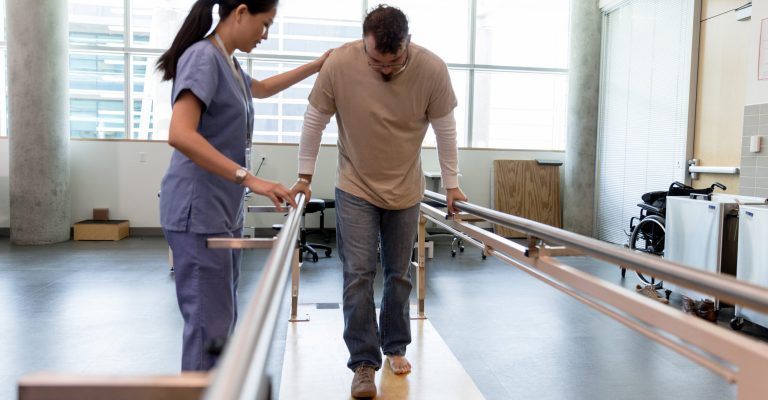A stroke is a disorder that may be life-threatening and affects millions of individuals all over the globe.
One of the most typical aftereffects of having a stroke is experiencing weakness or paralysis in the limbs below the waist.
Stroke sufferers may find it difficult to conduct even the most fundamental activities due to this, such as walking or climbing stairs.
The patient’s strength, flexibility, and mobility may all be improved by undergoing physical therapy, which is a vital component of rehabilitation after a stroke. Here, stroke exercises for legs play a great role.
Leg Exercises for Stroke Patients

Lower limb exercises for stroke patients are effective because they may assist in enhancing the function of the lower limbs, which are often impaired after a stroke.
In this piece, we will talk about various leg strengthening exercises for stroke patients that may be useful and helpful in getting them to walk again after having a stroke.
Ankle Pumps
This exercise promotes flexibility in the ankle and foot, which in turn contributes to improving circulation. The patient should either sit or lay down in a comfortable posture, then raise their foot up and down many times while continuing to repeat the exercise.
When doing these exercises for hemiparesis leg, the patient needs to concentrate on tensing the muscles in their feet and ankles.
Heel Slides
Flexibility in the knees and hips may be improved with the aid of this exercise. The patient has to be positioned to lie on their back with their knees bent and their feet completely flat on the ground.
After that, they should repeat the motion numerous times, sliding their heel in the direction of their buttocks as slowly as possible.
During this particular exercise, the patient should concentrate on keeping the muscles in their thighs as relaxed as possible.
Leg Lifts
How do you strengthen a weak leg after a stroke? Strengthening is they key, actually! Strength in the thigh muscles may be improved with this particular workout.
The patient should lay on their back with their legs straight, then pull one leg towards the ceiling numerous times while continuing to repeat the activity.
When the patient lifts their leg, they should concentrate on tightening the muscles in their thighs and maintain that tension for several seconds before releasing it and lowering their leg again.

Knee-to-chest
The flexibility of the hip and thigh muscles is improved due to doing this exercise. While lying on their back, the patient should pull one knee up to their chest and maintain the posture for a few seconds before releasing it and returning it to its initial position.
During this exercise, the patient should focus on maintaining a pushed-against-the-floor position for their lower back. These are extremely easy leg exercises for stroke patients.
Step-ups
This exercise enhances balance and leg muscular strength, making it a valuable addition to any workout routine. Using a step or a low bench, the patient has to step up and down with each foot, doing the exercise many times.
This should be done numerous times. When the patient is stepping up and down, they should concentrate on maintaining their knee above their ankle.
Quadriceps Sets
Strength in the thigh muscles may be improved with this particular workout. The patient has to get on their back, tense the muscles on the front of their thighs, and hold that contraction for a few seconds before releasing it.
After that, they should relax those muscles. During this exercise, the patient should concentrate on maintaining their knee in a straight position.
Inverted or Reversed Half Squat
This is a more complex version of the strengthening workout. Patients recovering from a stroke who have restricted movement should proceed with care. Try practicing in front of a table or desk that you can grip for support to reduce the risk to your safety.
Stand in a robust posture with your legs spread more apart than usual than they usually would be. The next step is to rise halfway, but not all the way, and then sit back down again. You can have a little stinging sensation in your quadriceps. This indicates that you are weakening your leg muscles in preparation for your body to rebuild them more powerfully than they were previously.
Toe Taps
Strength in the muscles of the foot and ankle may be improved with the aid of this exercise. The patient has to be seated in a chair and instructed to tap each of their toes on the floor alternatively. This action needs to be performed many times.
The patient should be mindful of maintaining a straight knee while tapping their toes and should make an effort to contract the muscles in their ankles and feet while they carry out this activity.
Calf Raises
Calf muscles may be made more potent with this particular workout. The treated individual should stand with their feet spaced hip-width apart, lift their heels off the ground and repeat the exercise many times.
When the patient raises their heels, they should concentrate on tightening the muscles in their calves and maintaining that tension for a few seconds before releasing it and lowering their heels again. You can perform these leg exercises for stroke patients at home.
Balance Exercises
The patient’s coordination and balance will benefit from the activity you have them do. Before shifting their weight to their other foot, the patient should stand on one foot and maintain that posture for a few seconds.
To increase the exercise’s difficulty and provide the patient with a new challenge, they may attempt standing on an unstable platform such as a balancing board or foam pad.
It is important to note that these leg exercises for stroke patients should only be done under a physical therapist’s guidance and that the exercises’ intensity and frequency should be tailored to the individual patient’s needs and abilities.
In addition, it is essential to pay attention to the patient’s degree of pain and discomfort and make appropriate exercise modifications based on this information. This one is a good exercise for stroke patients legs and arms both.

How to Get Back to Walking with Leg Exercises for Stroke Patients
Individuals who have had a stroke may find participating in physical therapy stroke leg weakness exercises extremely useful.
These exercises can enhance the patient’s strength, flexibility, coordination, balance, and mobility in the lower limbs.
These exercises should be carried out under the supervision of a physical therapist, and the level of difficulty and the number of repetitions should be modified according to the specific requirements and capabilities of the particular patient.
Patients who have had a stroke may improve their quality of life and recover their independence with the assistance of a physical therapist and by engaging in regular physical activity.
Frequently Asked Questions
If you or a loved one has experienced a stroke, you may have questions about the best exercises to improve leg strength and mobility – here are some frequently asked questions to help address those concerns.
Are there modifications for these exercises to accommodate different levels of ability after a stroke?
Yes, these exercises can be modified based on the individual’s specific needs and abilities. A physical therapist should guide the intensity, frequency, and modifications for these exercises to ensure safety and effectiveness.
How often should these exercises be performed, and for how long?
The frequency and duration of these stroke lower limb exercises will vary for each individual, depending on their abilities and progress in therapy. Generally, these exercises should be performed at least 3-4 times a week for about 30 minutes per session.
Besides these exercises, what other types of physical therapy are helpful for stroke recovery?
Many leg exercises for stroke patients can be done at home, but it is crucial to have professional supervision initially to ensure proper form and modifications. Other types of physical therapy that may be helpful for stroke recovery include gait training, range of motion exercises, and functional training specific to daily activities.
How can family members or caregivers support a stroke patient in performing these exercises?
Some potential risks are associated with these exercises, such as muscle soreness or strain. Family members or caregivers can provide support by encouraging patients to exercise regularly and offering emotional support. They may also assist in setting up a safe space for the exercises and monitoring proper form and modifications as needed.


